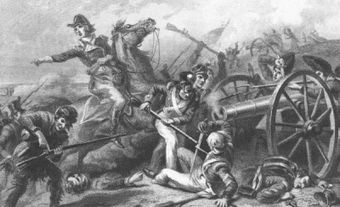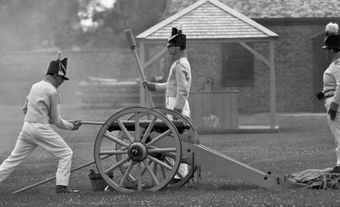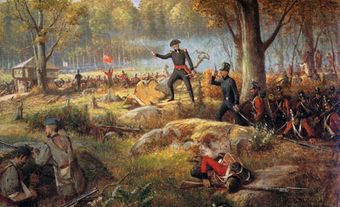Fort Erie National Historic Site recognizes a particularly strategic site during the War of 1812 at the entrance to the Niagara River from Lake Erie at the southeast corner of the Niagara Peninsula. Located in the town of Fort Erie, Ont, Old Fort Erie, as it is known, was designated as a national Historic Site in 1931, but is under the ownership and care of the Niagara Parks Commission. It is one of the Niagara area's most popular heritage attractions.
In 1901, the Niagara Parks Commission was granted a license of occupation from the federal government for the property (7.1 hectares) surrounding the fort. The commission began to improve the grounds in 1905, the same year a 9-metre-high granite memorial was erected on the site by the Ontario government to commemorate the fort's role in Canada's history and to honour those who died there.
The restoration of Fort Erie began in 1937 with funding provided by the federal and provincial governments as part of a create work project during the Great Depression. The restored fort was completed 2 years later. In the form of a square with bastions, curtains and buildings of solid masonry, it officially opened to the public on 1 July 1939.
An interpretation centre is on the site and guided tours of the fort are available that feature various demonstrations by costumed interpreters. Since 1986, an annual re-enactment of the Siege of Fort Erie has taken place on its grounds.
Fort Erie's History
The British built the first Fort Erie in 1764 to protect lines of communication along the Niagara River. In the early spring of 1799, a severe storm drove giant masses of ice from the lake into the fort, inflicting heavy damage. A new fort, built south of the earlier one, suffered a similar fate during a wild winter storm on 5 February 1803. A third version was wisely built on higher ground to the rear of the previous ones between 1804 and 1807.
During the early morning of 3 July 1814, a vast American invasion force that had crossed the Niagara River from Buffalo, New York, surrounded the fort. With only a small garrison, the commander at Fort Erie surrendered that afternoon. The American advance into Upper Canada was checked 22 days later at the Battle of Lundy's Lane and the American army fell back on Fort Erie.
The British, under the command of Lieutenant General Gordon Drummond, appeared before the fort in early August and made plans for an assault on the American position. That attack began during the early hours of 15 August. After severe fighting, the British managed to capture the fort's northeast bastion, but before any further progress could be made, a large supply of ammunition stored under the bastion's wooden floor suddenly blew up. The horrendous explosion caused a great loss of life. Those British who could still walk quickly retreated. Despite the devastating loss, it was not until 21 September that Drummond lifted the siege. The Americans evacuated Fort Erie on 5 November 1814, and returned to the New York State side of the Niagara River. Before departing, they largely destroyed the fort so that it would be of no value to the British. It was never reconstructed as a military post and was occupied only occasionally by British forces until 1823.
The fort's ruins were the campsite of another invasion force from the United States during the night of 2-3 June 1866. During their brief foray into Canada, Colonel John O'Neill and his Fenian Brotherhood supporters camped here after their success at the Battle of Ridgeway.

 Share on Facebook
Share on Facebook Share on X
Share on X Share by Email
Share by Email Share on Google Classroom
Share on Google Classroom


